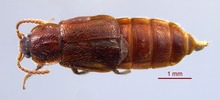

| Omaliinae | |
|---|---|

| |
| Acidota subcarinata | |
| Scientific classification | |
| Domain: | Eukaryota |
| Kingdom: | Animalia |
| Phylum: | Arthropoda |
| Class: | Insecta |
| Order: | Coleoptera |
| Family: | Staphylinidae |
| Subfamily: | Omaliinae MacLeay, 1825 |
The Omaliinae are a subfamily of the Staphylinidae, rove beetles.[1]
Typical adults are 1.5 to 6 mm long, somewhat broader in shape than are most Staphylinidae, with somewhat longer elytra (without serial punctures), the head with a broad neck, the antennae which are only slightly broader at the apex, and tarsi of five articles. In almost all genera is a pair of ocelli near the base of the head, and in a few, the elytra cover the entire abdomen. The maxillary mala of larvae are strap-shaped, but not as long as in the Proteininae, and the mandible lacks a prostheca.
Adults and larvae occur in leaf litter, decaying fruits, moss, and under bark of dead trees. Adults of several species and larvae of a few occur in flowers. Adults and larvae of many genera and species are believed to be predatory (they feed on freshly killed small insects), though a few seem to be phytophagous (they damage flowers) or saprophagous (they feed on decaying fruits).
The Omaliinae subfamily is large (comprising over 100 genera), and is divided into these seven tribes:
In North America, 55 genera and more than 200 species are found.
| Omaliinae |
|
|---|---|